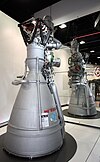Vacuum thrust
In rocket engines, vacuum thrust refers to the thrust that the engine generates in a vacuum . The vacuum thrust is different from the starting thrust. This is due to the fact that the thrust of a rocket engine depends on the pressure ratio between the combustion chamber and the environment. This pressure difference is naturally greater in a vacuum. In the case of multi-stage rockets, usually only the launch thrust is mentioned for the engines of the first stage . For the stages above, which are operated in a vacuum, usually only the vacuum thrust is mentioned.
Examples
| Engine | Start thrust | Vacuum thrust | use | |
|---|---|---|---|---|
 |
Rocketdyne RS-68 | 2,819 kN | 3,314 kN | Delta IV first stage, Ares V first stage |
 |
NPO Energomash RD-170 | 7,550 kN | 7,900 kN | Energija 11K25 booster |
 |
SNECMA Vulcain 1 | 815 kN | 1,120 kN | Ariane 5 first stage |
 |
Kuznetsov NK-33 | 1,505 kN | 1,638 kN | N-1 first stage, modified to the Aerojet AJ26 in Kistler K-1 |
 |
RD-107 (on the outer blocks) | 821 kN | 995 kN | R-7 (and variants) outer blocks |
literature
- Eugen Reichl, Aydoğan Koç: Space knowledge . 1st edition. Motorbuch Verlag, Nuremberg, 2006, ISBN 978-3-613-02666-7 .